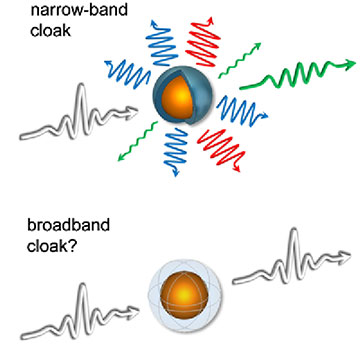
In a typical narrowband metamaterial cloak, scattering of light is “redistributed,” with scattering dramatically reduced in the cloaked wavelength but enhanced in neighboring wavelengths (top). The researchers asked whether broadband cloaking, encompassing the entire visible range, was possible (bottom). [Image: Monticone and Alù, Optica, doi: 10.1364/OPTICA.3.000718]
Invisibility cloaks and starship cloaking devices have been staples of fantasy and science fiction for generations. And, in the real world, metamaterials-based cloaks have lately shown an impressive ability to suppress electromagnetic scattering from certain objects at specific, narrow frequency bands. Yet the dream of a cloak that can shield a human, an aircraft or another macroscopic object from broadband visible-light observation has remained elusive.
Now OSA Fellow Andrea Alù and grad student Francesco Monticone of the University of Texas, Austin (USA), have put some bounds on what might be possible with metamaterial-based cloaking devices (Optica, doi: 10.1364/OPTICA.3.000718). The bad news: Achieving practical broadband invisibility cloaks will require some fundamentally new research directions. The good news: The work by Alù and Monticone offers some tools to help illuminate that way forward.
Redistributing scattering
Alù and Monticone looked specifically at so-called passive cloaks—that is, cloaks made from custom metamaterials that don’t draw energy from an external power source. Work starting early in the 21st century showed that certain such metamaterials could, at limited wavelengths and for objects of specific sizes, can achieve invisibility through a number of mechanisms, including transformation optics and plasmonic effects.
In general, the scientists note, these narrowband passive cloaks act by “redistributing” light scattering among different wavelengths—reducing scattering in the narrow, cloaked frequency band, but increasing scattering for other colors. Alù and Monticone wanted to know if that placed any fundamental limits on the ability to realize broadband cloaking, and if so what those limits were—questions, obviously, with huge implications for practical cloaking applications.
Borrowing from microwave theory
To start getting at the answers, the researchers turned to a framework from microwave circuits and communications—Bode-Fano theory, developed as an aid to impedance matching in microwave networks to minimize unwanted reflections. The UT scientists saw analogies between that problem and the general issue of optical cloaking, and they set to work adapting the Bode-Fano math to the optical problem. Then, they used their new framework to model planar and 3-D objects under plane-wave illumination.
What they found is that, as an object gets larger and larger relative to the incident wavelength of light, more and more scattering harmonics are excited, in a way that can be rigorously modeled by the theory (and, indeed, summed up in a single, simple equation). For the cloak to work, all of those harmonics need to be minimized at each relevant frequency. As a result, for large objects such as aircraft, or humans, broadband cloaking “is impossible with linear and passive cloaks of arbitrary complexity.” The model also explains why it is possible, for example, to cloak a medium-size radio antenna from radio waves over a relatively broad bandwidth, since the antennas and the waves are of comparable size.
Alternative approaches
On the bright side, according to the study, the new model offers a sort of toolkit for assessing the practicality of narrowband cloaking technologies in specific scenarios. And even for broadband cloaking, all is not lost. While passive cloaks face fundamental limits in the quest for true, broadband invisibility, Alù and Monticone note that other approaches might still allow progress toward that goal.
Those approaches, for example, might include active or nonlinear cloaks that tap external energy sources, to which the modeled passive-cloak limits don’t apply—and on which Alù’s lab is actively working. Alternatively, notes Monticone in a press release, “we can aim for looser forms of invisibility”—traditional, camouflage-like approaches; introducing phase delays as light is transmitted through; or what Monticone calls “other optical tricks,” such as cloaking using paraxial ray optics, where the invisibility is not required to be omnidirectional.
